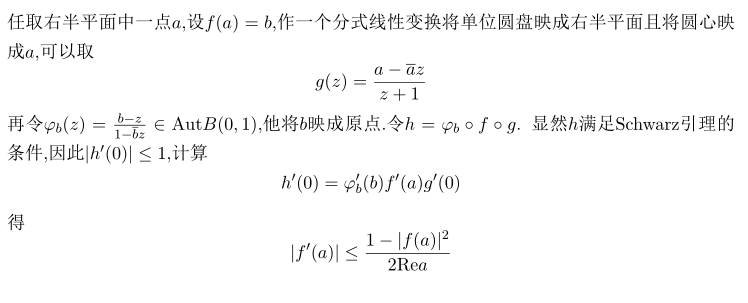复分析作业
1.设$\displaystyle f_n\in O(D),f_n\rightrightarrows f$, $\displaystyle S_n=\cup_{k\geq n}f_k(D)$,令$\displaystyle S=\cap_{n=1}^\infty S_n$.问$S$的内部$\mathring{S}$和$f(D)$有什么关系?
2.Schwarz引理: $f:\triangle\to \triangle$解析, $f(0)=0$,则$|f'(0)|\leq 1$,并且$|f'(0)|= 1\Leftrightarrow f\in \mathrm{Aut} (\triangle)$.
一般地,固定$z_0\in\triangle$,定义$\mathscr{F}_{z_0}=\{f:\triangle\to \triangle\,\text{解析}|f(z_0)=0\}$,令$\lambda=\sup\{|f'(z_0)|f\in \mathscr{F}_{z_0}\}$.由Cauchy不等式, $\lambda<+\infty$.当然易证$\lambda>0$.取$f_n\in \mathscr{F}_{z_0}$,使得$\lim_{n\to\infty}|f'_n(z_0)|=\lambda$.由Montel定理,不妨设$f_n\rightrightarrows f$,则$f\in \mathscr{F}_{z_0}$且$|f'(z_0)|=\lambda$.
(1)求出$\lambda$;
(2)若$f\in \mathscr{F}_{z_0}$,则$f\in \mathrm{Aut} (\triangle) \Leftrightarrow |f'(z_0)|=\lambda$.
3.设$f_n,g_n\in O(\triangle),n\geq 1$,设$|f_n(z)|\leq 2,|g_n(z)|\leq 2,|f_n(z)g_n(z)|\leq\frac1n,\forall z,\forall n$.设$f_n(0)=0,g_n(0)=1,\forall n$.设$\{z_n\}$是$\triangle$中子列,若满足$f_n(z_n)=1,g_n(z_n)=0,\forall n$,则$\lim\limits_{n\to\infty}|z_n|=1$.
4.对$r\in (0,1)$,记$A_r=\{z\in \mathbb{C}|r<|z|<1\}$
(1)对$\forall r\in (0,1)$,证明$A_r,\triangle^\ast,\mathbb{C}^\ast$不共形等价;
(2)设$r_1,r_2\in (0,1)$,若$A_{r_1}\cong A_{r_2}$,则$r_1=r_2$;
(3)计算$A_r$的自同构群$\mathrm{Aut}(A_r)$.
5.证明$\mathbb{C}^\ast,\triangle^\ast,A_r$同胚.
Let $q>0$ such that $[q[qn]]+1=[q^2n],n=1,2,\cdots$,solve $q$.
球面$S^n$的Levi-Civita联络是$\mathbb{R}^{n+1}$的联络到球面的切空间的投影,也就是$$\nabla_{X}Y(\vec{x})=D_{X}Y(\vec{x})-\langle D_{X}Y(\vec{x}) , \vec{x}\rangle\vec{x},$$其中$D$是欧氏空间的联络,也就是普通的方向导数,设$\gamma$是球面的弧长参数的测地线,于是测地线方程是\begin{align*}0&=D_{\dot{\gamma}}\dot{\gamma}(\gamma)-\langle D_{\dot{\gamma}}\dot{\gamma}(\gamma) , \gamma\rangle\gamma=\ddot{\gamma}-\langle \ddot{\gamma} , \gamma\rangle\gamma\\&=\ddot{\gamma}-(\frac{d}{dt}\langle \dot{\gamma} , \gamma\rangle-\langle\dot{\gamma} , \dot{\gamma}\rangle)\gamma=\ddot{\gamma}-(\frac{d}{dt}0-1)\gamma.\end{align*}
也就是$\ddot{\gamma}=-\gamma$, 容易解得$\gamma(t)=\cos t\cdot\gamma(0)+\sin t\cdot\dot{\gamma}(0)$.
一、(30分)设$\displaystyle {S^n}\left( r \right) = \left\{ {x = \left( {{x^1}, \cdots ,{x^{n + 1}}} \right) \in {\mathbb{R}^{n + 1}}\left| {\sum\limits_{A = 1}^{n + 1} {{{\left( {{x^A}} \right)}^2}} = {r^2},r > 0} \right.} \right\}$是$\mathbb{R}^{n + 1}$的半径为$r$的球面, $g_0=\sum_{A=1}^{n+1}\left(d x^A\right)^2$是$\mathbb{R}^{n + 1}$的标准黎曼度量.令$i:S^n (r)\to \mathbb{R}^{n + 1}$是包含映射.
两个奇怪的积分

第一个积分的解答:
第二个积分的另一种求法:
来自:http://math.stackexchange.com/questions/324647/integrate-int-01x-x1-xx-1-sin-pi-xdx
http://math.stackexchange.com/questions/958624/prove-that-int-01-sin-pi-xxx1-x1-x-dx-frac-pi-e24
i的i次方等于多少?
史济怀复变习题解答
本文主要给出史济怀老师复变函数的某些习题解答,主要来自陶哲轩小弟。


然后对后面的函数用最大模原理.




涉及到一个有意思的方程的积分
求证:\begin{align*}&2{\left( {\int_0^\pi {\frac{x}{{{x^2} + {{\ln }^2}\left( {2\sin x} \right)}}dx} } \right)^7} + 53{\left( {\int_0^\pi {\frac{x}{{{x^2} + {{\ln }^2}\left( {2\sin x} \right)}}dx} } \right)^5} + {\left( {\int_0^\pi {\frac{x}{{{x^2} + {{\ln }^2}\left( {2\sin x} \right)}}dx} } \right)^4}\\&+ {\left( {\int_0^\pi {\frac{x}{{{x^2} + {{\ln }^2}\left( {2\sin x} \right)}}dx} } \right)^3} + 19\int_0^\pi {\frac{x}{{{x^2} + {{\ln }^2}\left( {2\sin x} \right)}}dx} = 2014\end{align*}
证明:Here is a proof, using complex analysis, that the integral is equal to $2$. Put
